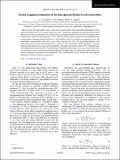| dc.contributor.author | Goodman, Aaron Jacob | |
| dc.contributor.author | Willard, Adam P. | |
| dc.contributor.author | Tisdale, William | |
| dc.date.accessioned | 2018-04-04T20:23:14Z | |
| dc.date.available | 2018-04-04T20:23:14Z | |
| dc.date.issued | 2017-09 | |
| dc.date.submitted | 2017-08 | |
| dc.identifier.issn | 2469-9950 | |
| dc.identifier.issn | 2469-9969 | |
| dc.identifier.uri | http://hdl.handle.net/1721.1/114549 | |
| dc.description.abstract | Here, we show that deep trapped “dark” exciton states are responsible for the surprisingly long lifetime of band-edge photoluminescence in acid-treated single-layer MoS₂. Temperature-dependent transient photoluminescence spectroscopy reveals an exponential tail of long-lived states extending hundreds of meV into the band gap. These subband states, which are characterized by a 4 μs radiative lifetime, quickly capture and store photogenerated excitons before subsequent thermalization up to the band edge where fast radiative recombination occurs. By intentionally saturating these trap states, we are able to measure the “true” 150 ps radiative lifetime of the band-edge exciton at 77 K, which extrapolates to ∼600 ps at room temperature. These experiments reveal the dominant role of dark exciton states in acid-treated MoS₂, and suggest that excitons spend >95% of their lifetime at room temperature in trap states below the band edge. We hypothesize that these states are associated with native structural defects, which are not introduced by the superacid treatment; rather, the superacid treatment dramatically reduces nonradiative recombination through these states, extending the exciton lifetime and increasing the likelihood of eventual radiative recombination. | en_US |
| dc.description.sponsorship | National Science Foundation (U.S.) (Grant 1122374) | en_US |
| dc.publisher | American Physical Society | en_US |
| dc.relation.isversionof | http://dx.doi.org/10.1103/PhysRevB.96.121404 | en_US |
| dc.rights | Article is made available in accordance with the publisher's policy and may be subject to US copyright law. Please refer to the publisher's site for terms of use. | en_US |
| dc.source | American Physical Society | en_US |
| dc.title | Exciton trapping is responsible for the long apparent lifetime in acid-treated | en_US |
| dc.type | Article | en_US |
| dc.identifier.citation | Goodman, A. J. et al. "Exciton trapping is responsible for the long apparent lifetime in acid-treated." Physical Review B 96, 12 (September 2017): 121404(R) © 2017 American Physical Society | en_US |
| dc.contributor.department | Massachusetts Institute of Technology. Department of Chemical Engineering | en_US |
| dc.contributor.department | Massachusetts Institute of Technology. Department of Chemistry | en_US |
| dc.contributor.mitauthor | Goodman, Aaron Jacob | |
| dc.contributor.mitauthor | Willard, Adam P. | |
| dc.contributor.mitauthor | Tisdale, William | |
| dc.relation.journal | Physical Review B | en_US |
| dc.eprint.version | Final published version | en_US |
| dc.type.uri | http://purl.org/eprint/type/JournalArticle | en_US |
| eprint.status | http://purl.org/eprint/status/PeerReviewed | en_US |
| dc.date.updated | 2017-11-14T22:45:57Z | |
| dc.language.rfc3066 | en | |
| dc.rights.holder | American Physical Society | |
| dspace.orderedauthors | Goodman, A. J.; Willard, A. P.; Tisdale, W. A. | en_US |
| dspace.embargo.terms | N | en_US |
| dc.identifier.orcid | https://orcid.org/0000-0002-0159-5646 | |
| dc.identifier.orcid | https://orcid.org/0000-0002-6615-5342 | |
| mit.license | PUBLISHER_POLICY | en_US |
